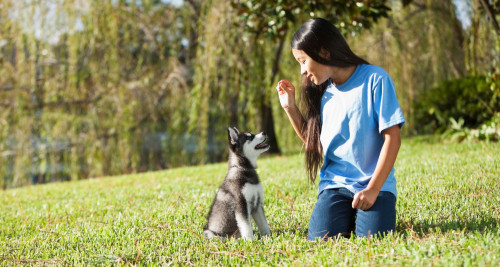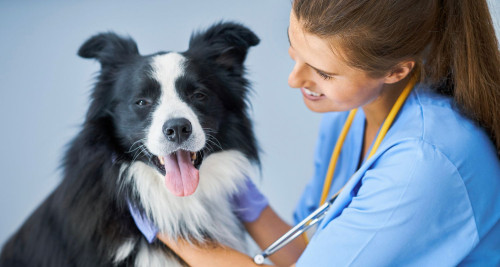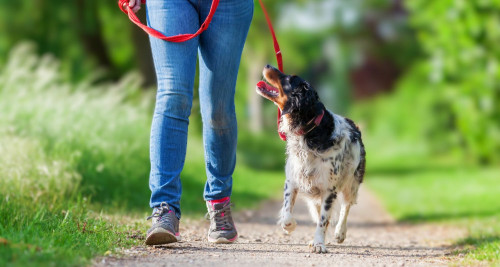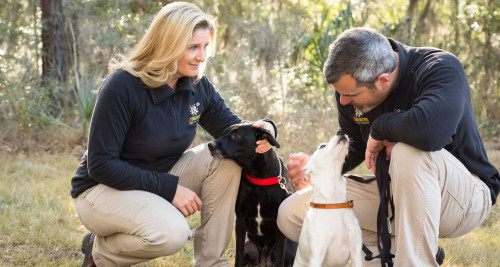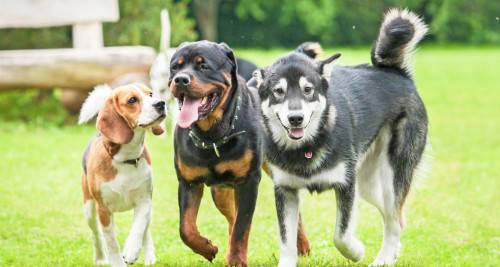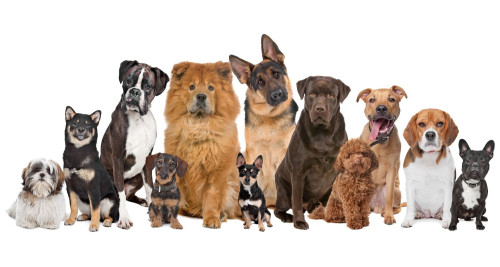Cavalier King Charles Spaniel
Breed Traits and Characteristics
According to the American Kennel Club, here are some breed characteristic you can find in Cavalier King Charles Spaniels.
- Height
12-13 inches
- Weight
13-18 pounds
- Life Expectancy
12-15 years
- Coat Type/Length
Wavy-Silky/Medium
-
100 Affectionate with Family
-
100 Good with Young Children
-
100 Good with Other Dogs
-
80 Trainability Level
-
60 Energy Level
-
60 Barking Level
-
40 Shedding Level
-
40 Drooling Level
History
The Cavalier King Charles Spaniel and the English Toy Spaniel are often confused. The two breeds share similar history and only diverged approximately 100 years ago. In the United Kingdom, the English Toy Spaniel is called the King Charles Spaniel. In the United States, one of the colors of the Toy Spaniel is known as King Charles.
There are several major differences between the two breeds, however the primary difference is size. The Cavalier’s average weight is between 13 to 18 pounds (5.9 to 8.2 kg). The King Charles is slightly smaller averaging 9 to 15 pounds (4.1 to 6.8 kg). With similar facial features, the Cavalier's ears are set higher and its muzzle length longer. The Cavalier’s skull is flatter while the King Charles's has a domed skull.
During the 18th century, John Churchill, 1st Duke of Marlborough, kept chestnut and white colored King Charles Spaniels, which were used for hunting. The Duke recorded that they were able to keep up with a trotting horse. The Dukes estate was called “Blenheim” after the Battle of Blenheim. Thus, chestnut and white Cavalier King Charles Spaniels and King Charles Spaniels soon became known as “Blenheim” colored.
The breed’s history in the USA is relatively short. The first recorded Cavalier living in the United States was brought from the United Kingdom in 1956.
The Cavalier King Charles Spaniel
The Cavalier King Charles Spaniel is one of the oldest and most stable breeds of dogs. Having originated in the United Kingdom this breed has a long noble history. Today, the Cavalier King Charles Spaniel is among the 20 most popular breeds in the United States, largely due to its stable personality, loving way, and appealing looks – an ideal family dog.
The Cavalier King Charles is classed as a ‘toy’ breed and is one of the smallest Spaniels. A compact little dog which may make an excellent travel companion.
Here's what the AKC says about the Cavalier King Charles Spaniel:
"The Cavalier’s all-around beauty, regal grace, and even temper mark him as one of dogdom’s noblemen. A toy spaniel no more than 13 inches high, the Cavalier draws you in with his face: The sweet, gentle, melting expression emanating from large, round eyes is a breed hallmark. Another is the silky, richly colored coat that can be one of four distinct varieties.
Cavaliers may be aristocrats, but they gladly descend from their royal high horse for a backyard frolic or a squirrel chase. They get along nicely with children and other dogs. Adaptable Cavaliers do equally well with active owners and homebodies—they can be upbeat athletes or shameless couch potatoes, depending on an owner’s lifestyle."
Cavalier King Charles Spaniel Breed Facts
Physical Characteristics
The Cavalier King Charles Spaniel is one of the smallest spaniels. The breed has short legs, a lustrous coat, long ears, and a natural long feathered tail. Cavalier King Charles Spaniels have an appealing look with a kind face that what will instantly win your heart. Puppies tend to look like plush (or “stuffed”) toy dogs.
The Cavalier King Charles Spaniel is the quintessential lap dog and is small as far as Spaniels go, with fully grown adults comparable in size to adolescents of other larger spaniel breeds.
Cavalier King Charles has a muzzle and a more elongated face – not to be confused with the King Charles Spaniel, that has a flat ‘human like’ face.
The breed has four main coat colors, including, black and tan; chestnut and white (known as the “Blenheim”); black, white and tan; and a deep red or ruby color (referred to as “Ruby”).
Personality & Temperament
In our opinion, The Cavalier King Charles has one of the most stable temperaments of all the toy breeds. Generally, this breed has a loving and easy-going personality and is outgoing and usually sociable with other dogs.
Most Cavalier King Charles Spaniels have few behavioral or training issues and those we have been called in to help are situations where most often the dog has been over-indulged and received no form of basic education or proper socialization. In most cases, these issues are easily turned around and we have dog and human communicating in no time.
Unique Breed Traits
- Fun-loving and sweet
- Easy to train
- Great for apartment or condo living
- Great family dog
- Easy to groom/coat care
- Known for nuisance barking
- Obsessive with catching flies
- Doesn’t require much physical exercise
- Great lap dog
- Generally good with other dogs
Bark Busters Trainer Jeff Drier on the Cavalier King Charles Spaniel
Who can resist Cavalier King Charles Spaniels? They are sweet beautiful little dogs that can fit into almost any lifestyle and are usually great with children and other animals. They can be great “starter” dogs for people who have never had a dog before. As with any dog, they need an education and people do need to understand dog nature and some simple facts.
Fact 1 – Dogs will repeat behavior that rewards them. This can be a challenge with Cavalier King Charles Spaniels for the simple reason that they are so adorable. I like to read the paper in the morning while I have my coffee. Imagine Charley, a cute little Cavalier pup, coming over and putting his paws on my leg to get attention. If put my paper and coffee down and reach down to pet Charley I have rewarded his attention seeking. I am teaching him that it’s ok to interrupt me. It might not be a big deal right now but there will be times when it will be. Be careful when you reward a pup and make sure you only reward good behavior. Your attention and affection are probably the biggest rewards you typically can give a dog.
Pups and dogs learn very quickly the things we enjoy doing with them and they make it easy for us to respond to them by asking us to do the things we enjoy. When we do respond to their sweet request’s dogs will take it to mean we are the followers and they are the leaders. When this happens, they will often start making other decisions, based on their canine perceptions and understanding. These decisions rarely align with our decisions.
Fact 2 – Dogs speak their own language. Dogs can learn words and its not uncommon for them to learn to associate over 100 words and some dogs over 1000, but they really don’t speak any human language they speak their own canine language which is a combination of body language, vocal tones (barks, cries, growls, howls etc.) and postures and actions. It is much easier to us to learn their language than for them to learn ours. Dogs will learn hand signals quicker than they will learn words because these are body language, which dogs are experts at reading and understanding. By combining hand signals with vocal cues, you can begin to teach your pup some words, but dogs will never understand the nuances of human language. Bark Busters will teach you to “Speak Dog.”
Fact 3 – Dogs are not deliberately naughty or bad, they do things that either come naturally to them or that they have learned. Things that will get reactions often get repeated. As with Charley coming over to interrupt my morning coffee and paper reading, most likely if I didn’t respond he would have found something else to do. If you come home from being out and find that your favorite quilt now has holes in it, the dog didn’t do it because he was mad at you for going out without him. He may have been bored or he may have been stressed but he didn’t do it to “get back at you”. That is not a dog’s nature, although it might seem that way to us. Chewing is a natural dog behavior as is digging. Dogs don’t read or watch TV to occupy themselves and if you don’t give them something to occupy themselves and stave off boredom, they will find something to do on their own, which might not be what you want them doing.
We were called to help a young woman whose Cavalier King Charles named Sophia, was barking when the woman went out. They lived in an apartment complex and some of the neighbors had complained to the management. We discovered that the woman, was giving in to every request that Sophia had. This created the feeling in Sophia that it was her responsibility to “take care” of the woman. When the woman was out, Sophia became stressed, much like a mother whose young child had wandered away. Sophia’s stress was manifest by barking. We helped the woman with a plan to change their roles so that she was the leader there, not Sophia. Sophia was able to relax and not worry about the woman. The result was that Sophia just played with her toy then curled up and napped when the woman went out. The frantic barking became a thing of the past.
The Cavalier King Charles Spaniel is typically a very easy dog to train, they want to please and want to be part of the activity. As mentioned, they will fit into a variety of lifestyles and home environments including small apartments. Rarely will these dogs be difficult or troublesome, but as with every dog, they will need an education in order to help them fit into your family. Bark Busters are the world’s experts at helping people teach their dogs how to become great family members. We have trained over one million dogs since 1989. Our experience is unmatched and our life of the dog support guarantee gives people peace of mind knowing that addition help, whenever needed, is only a phone call away.
Selecting a Cavalier King Charles Spaniel Puppy
If you are looking for a Cavalier King Charles Puppy, we recommend you checking all the Cavalier rescue organizations first. Then, be sure you choose a reputable breeder. Animal shelters work hard to match the right owners with the right dogs, it’s not just about finding homes, it’s finding that ‘forever home’.
The majority of dogs are abandoned for the wrong reasons and some people are not fully prepared to do what it takes to train and educate a dog. Shelters give their dogs health checks to make sure they are in good shape and up-to-date on vaccinations and will make you aware of any behavioral issues. Bark Busters® trainers work with many local shelters to help overcome any behavioral issues before a dog is adopted.
A good breeder will try and screen out all the health problems inherent to the breed as much as possible. They should be happy to answer your questions about temperament and health considerations and should ask you questions about your lifestyle and goals. Many breeders are registered with the American Kennel Club’s American Cavalier King Charles Spaniel Club, where they abide by certain policies and screening.
No matter what route you decide, here are some questions to ask before you select a puppy:
- Is it hyperactive or too much of a handful for me?
- How is it around other pets?
- Does it seem aggressive with children?
- What is its personality like?
- What do you know about its Mom and Dad?
- Are there any inherent health issues that you know?
Before you decide on a puppy, ask yourself if you would be better off with an adult Cavalier, that would mean lower maintenance and lower energy. Puppies are fun, but they are also a lot of work.
Whether you acquire a puppy or adult make sure you take your dog to the vet soon after adoption to identify and prevent any problems and to check on its immunization and de-sexing needs.
Training Your Cavalier King Charles Spaniel
Separation Anxiety
Separation anxiety is one issue that is occasionally found in this breed. Also, nuisance barking, especially when left alone. This can stem from the fact that they are so adorable and loving, that you never want to leave them alone! This breed is very social and a great family dog but you also must train your dog so that it may be able to be left alone without acting up or feeling anxiety.
If your dog is always accustomed to being with you then when you have to go out with it it may cause your pup some stress. Consider setting some rules and be sure to teach your dog.
Here are some quick tips to use with your Cavalier:
- Your dog should not follow from room to room, or everywhere you go in the home.
- Always walk through doors first. This has two purposes, the leader always leads, and you can check that all is safe. This tip applies to everyone - all humans in the household should always go through all doors first.
- Be consistent! Dogs become confused and stressed if rules are not consistent.
- If you allow your dog on your bed or your furniture, consider mixing things up occasionally. For example, allow your dog on the furniture today but then choose to not allow them up tomorrow. This might seem counter-intuitive since we just talked about consistency. What we’re referring to is always controlling your dog’s access. As your dog’s leader you should be able to say “no” one day and “yes” the next without issue.
You don’t have to use our list, set your own ‘set of rules’ that work in your household and create your own list, then stick to them and your Cavalier will be a better version of him/herself.
Games to Play with Your Cavalier King Charles Spaniel
Cavaliers are great sports and love to play. Even though they are considered a lap dog, they are great companion dogs and up for anything you want them to do.
- Hide and Seek – Hide a ball/treat/yourself throughout your home and encourage your dog to find it!
- Fetch – Cavaliers love to chase balls and play with toys. Your dog will love a rousing game of fetch (challenge yourself to see how far you can throw it).
- Walking – This classic form of exercise is still great for all breeds, but make sure you don’t over-work an aged dog.
Walking Your Cavalier King Charles Spaniel Correctly
As previously mentioned, early education is important. Making sure your Cavalier walks properly on a leash is an important exercise. If your dog pulls on the leash, it can be damaging its skeletal frame. You should always start this training in the home and start with short walks and make them fun and educational. No need to go for long walks while educating.
Introducing the Leash
Many folks struggle to control their dogs when out on a walk regardless of their size.
We recommend starting when your Cavalier is still a puppy and educating your puppy where you want it to walk. That should not be straining at the leash.
Bark Busters are often asked why dogs pull on the leash and concerned ‘pet parents’ worry that their dog will be injured with all this pulling. Not to mention the toll the pulling takes on the human, the answer is simple, it’s all down to using the right technique, coupled with the right leash and equipment.
Dogs Naturally Pull Against a Tight Leash
Pressure on your dog’s neck is not good for the trachea or his skeletal frame. It also places unnecessary pressure on your arms and joints. It benefits neither you nor your dog and cannot be fun. Yet we all see this type of walking daily and it has to be because people don’t know there is a better way.
In the wild if an animal is trapped, it will naturally try to get away. It knows it is vulnerable if it is captured or tethered. Although the canine has been domesticated for thousands of years, your dog still has this instinct in its mind. The only way to avoid this natural pulling, is to learn to get your dog to walk on a loose leash.
Dogs are natural pullers. It’s in a dog’s DNA to pull against any restraint.
This is why it is possible to get a dog to pull a sled. When a dog feels a restraint it naturally pulls against the restraint. This is normal dog behavior, but we can alter the dog’s perception if we always keep the dog on a loose leash, where it feels NO restraint.
Connect with Us!
Need help training your Cavalier King Charles Spaniel? Call 1-877-500-BARK (2275)or enter your zip code.
Cavalier King Charles Spaniel Grooming
The Cavalier King Charles is an easy dog to care for and to groom. Cavaliers do shed, particularly in the spring and fall, but a little all the time, but not as much as other breeds with thick undercoats. The benefit of this coat is that they do not require regular clipping like a poodle or associated breeds.
Regular brushing and an occasional bathing are all that is required to keep the Cavalier King Charles clean and looking its best.
Remember that too much bathing will strip your dog’s coat of its natural oils. A warm wet towel wiped over your dog, can be used in between washes to keep them looking fresh and clean.
If your Cavalier King Charles has that ‘doggy smell’ do not assume your dog needs a bath, it might be a sign of a skin condition or allergic reaction. For example, Eczema has a distinctive pungent smell. Speak with your veterinarian for the best treatment for your dog. We also recommend researching the cause any skin problems, as there will be a reason behind why your dog is having skin issues. Treat the problem and also the cause!
Tips for Every Dog Owner
Hear from Bark Busters Clients Who Have a Cavalier King Charles Spaniel
Need Dog Training Assistance with your Cavalier King Charles? Find Your Local Trainer Now!
CALL TODAY 1-877-500-BARK (2275)
